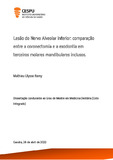| dc.contributor.advisor | SILVA, LUÍS MANUEL DUARTE MARTINS DA | |
| dc.contributor.author | Remy, Mathieu Ulysse | |
| dc.date.accessioned | 2022-11-04T11:45:42Z | |
| dc.date.available | 2022-11-04T11:45:42Z | |
| dc.date.issued | 2022 | |
| dc.identifier.uri | http://hdl.handle.net/20.500.11816/4058 | |
| dc.description.abstract | A lesão do nervo alveolar é uma das complicações mais frequentes e mais graves durante a exodontia dos terceiros molares mandibulares inclusos. Pode ser explicado pela relação estreita com o nervo alveolar inferior. Em 1984, foi iniciada a coronectomia, uma técnica alternativa à exodontia e que tem como objetivo reduzir o risco de provocar lesão do nervo alveolar inferior. A coronectomia consiste na remoção da coroa do dente e retenção das raízes no alvéolo.
O objetivo desta revisão sistemática integrativa é determinar qual técnica cirúrgica, entre a exodontia e a coronectomia, que apresenta o menor risco de provocar lesão do nervo alveolar inferior no tratamento dos terceiros molares mandibulares inclusos.
Realizou-se uma pesquisa bibliográfica de artigos científicos considerados relevantes sobre o tema na base de dados “PubMed”. Após a análise foram incluídos 21 artigos.
Os resultados mostraram uma maior incidência de lesão do nervo alveolar inferior quando é efetuada uma exodontia em comparação à coronectomia.
A lesão temporária após exodontia foi verificada em 4,7% dos casos enquanto na coronectomia acontece apenas em 1,1 % dos casos. Relativamente à lesão permanente do nervo, a exodontia apresenta também uma maior incidência com 0,4% de casos e ela é de 0,2% de casos para a coronectomia.
Podemos concluir que a coronectomia parece ser uma técnica segura e que permite ao médico dentista diminuir o risco de lesão do nervo alveolar nos terceiros molares mandibulares inclusos em relação anatómica estreita. | pt_PT |
| dc.description.abstract | Alveolar nerve injury is one of the most frequent and most serious complications during exodontia of mandibular third molar inclusions. It can be explained by the close relationship with the inferior alveolar nerve. In 1984, coronectomy was initiated, an alternative technique to exodontia and which aims to reduce the risk of causing injury to the inferior alveolar nerve. Coronectomy consists of removing the crown of the tooth and retaining the roots in the alveolus.
The aim of this integrative systematic review is to determine which surgical technique, between exodonty and coronectomy, presents the lowest risk of causing injury to the inferior alveolar nerve in the treatment of mandibular third molar inclusions.
A bibliographic search of scientific articles considered relevant on the subject was made in the "PubMed" database. After analysis 21 articles were included.
The results showed a higher incidence of inferior alveolar nerve injury when exodontia is performed in comparison to coronectomy.
Temporary lesion after exodontia was verified in 4.7% of the cases while coronectomy only occurs in 1.1% of the cases. Concerning permanent nerve damage, exodontia also presents a higher incidence with 0.4% of cases and it is 0.2% of cases for coronectomy.
We may conclude that coronectomy seems to be a safe technique and that it allows the dentist to reduce the risk of alveolar nerve lesion in inclused mandibular third molars in close anatomical relation. | pt_PT |
| dc.language.iso | por | pt_PT |
| dc.rights | info:eu-repo/semantics/openAccess | pt_PT |
| dc.subject | Third molar | pt_PT |
| dc.subject | Impacted | pt_PT |
| dc.subject | Inferior alveolar nerve | pt_PT |
| dc.subject | Injury | pt_PT |
| dc.subject | Tooth extraction | pt_PT |
| dc.subject | Coronectomy | pt_PT |
| dc.title | Lesão do Nervo Alveolar Inferior: comparação entre a coronectomia e a exodontia em terceiros molares mandibulares inclusos. | pt_PT |
| dc.type | info:eu-repo/semantics/masterThesis | pt_PT |
| dc.identifier.tid | 203075358 | pt_PT |
| thesis.degree.name | Mestrado em Medicina Dentária | pt_PT |

